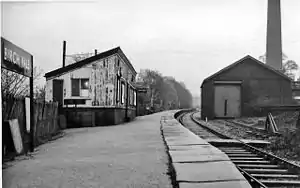Hayfield Branch | |||||||||||||||||||||||||||||||||||||||||||||||||
|---|---|---|---|---|---|---|---|---|---|---|---|---|---|---|---|---|---|---|---|---|---|---|---|---|---|---|---|---|---|---|---|---|---|---|---|---|---|---|---|---|---|---|---|---|---|---|---|---|---|
| |||||||||||||||||||||||||||||||||||||||||||||||||




The Hayfield Branch was a 2+1⁄2-mile (4 km) single-track branch line that ran along the Sett Valley from the Hope Valley Line near New Mills Central to Hayfield, via one intermediate stop, Birch Vale. It passed under the town of New Mills through the 180 m (200 yd) rock-cut Hayfield tunnel.
History
Opening

The branch opened, in 1868, to serve the villages along the valley of the River Sett and the local mills. It became the joint property of the Manchester, Sheffield & Lincolnshire Railway (later Great Central) and the Midland Railway. It remained a joint line, latterly owned by the London and North Eastern Railway and the London Midland Scottish Railway, until nationalisation of the railways in 1948.[1] Passenger numbers were high especially in the summer months, as the line provided easy access to the countryside.
The branch was subsequently assigned to the London Midland Region of British Railways. Introduction of diesel multiple unit (DMU) trains led to an improvement in passenger services and, by the 1960s, there was an hourly frequency to and from Manchester Piccadilly, with some additional trains at peak times. Unlike some neighbouring lines, the station also enjoyed an hourly Sunday service which was popular with walkers.
Kinder Reservoir
A short-lived continuation of the line was built in the early 20th century to convey materials and workmen during the construction of Kinder Reservoir.[2]
Closure
After World War II, passenger traffic on the line reduced. The whole Manchester Piccadilly-Romiley-Hayfield line had been included in the 1963 Beeching cuts proposals; however, the government chose instead to retain the Hope Valley line in favour of closing the Woodhead line to passenger services. The Hayfield line was closed in January 1970.[3]
The site today
The line was purchased from British Rail by Derbyshire County Council in 1973 and now forms the Sett Valley Trail.[4]
References
- ↑ Holt, Geoffrey O. (1986) [1978]. A Regional History of the Railways of Great Britain. Vol. 10, The North West (Revised ed.). Newton Abbot: Atlantic Transport Publishers. ISBN 0946537348.
- ↑ Brumhead, Rangeley & Rangeley, Derek, Jean & Ken (2008). The Kinder Reservoir and Railway. New Mills: New Mills Heritage Centre.
{{cite book}}: CS1 maint: multiple names: authors list (link) - ↑ "The Reshaping of British Railways" (PDF). railwaysarchive.co.uk. 1963.
- ↑ "Sett Valley Trail, from Hayfield to New Mills, Derbyshire Peak District".